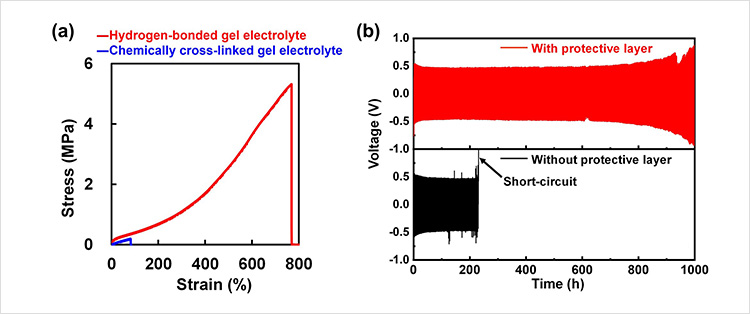Extending the Life of a Lithium Metal Anode Using a Protective Layer Made of an Extremely Tough Gel Electrolyte
—Anode Protection May Significantly Increase Lithium Secondary Battery Energy Density—
2023.04.19
National Institute for Materials Science (NIMS)
NIMS research team has succeeded in substantially improving the cycling performance of a lithium metal battery by developing a mechanically very strong polymeric gel electrolyte and integrating it into the battery as a layer to protect the lithium metal anode.
Abstract
- A National Institute for Materials Science (NIMS) research team has succeeded in substantially improving the cycling performance of a lithium metal battery by developing a mechanically very strong polymeric gel electrolyte and integrating it into the battery as a layer to protect the lithium metal anode. This achievement may greatly facilitate efforts to put lithium metal anodes—a potentially very high performance anode material—into practical use.
- Today’s society is rapidly transforming through the widespread use of digital technologies, the increasing popularity of electric vehicles and the growing use of renewable energy. These shifts have created a steadily rising demand for higher performance lithium secondary batteries. Lithium metal anodes have very large theoretical capacities and low working potentials. However, they also have an issue: the process of lithium dissolution and deposition, which occurs as the battery is charged and discharged, is prone to deterioration, shortening the batteries’ charge-discharge cycle lives and posing safety concerns. New technologies capable of stabilizing the charge-discharge cycles of secondary batteries equipped with lithium metal anodes are therefore needed.
- This research team developed mechanically tough and stretchable gel electrolytes formed by an organic solvent electrolyte containing a high concentration of lithium salts and a hydrogen-bonded polymer. The team then integrated this gel electrolyte as an artificial layer to protect the lithium metal anode. Experiments demonstrated that the addition of the protective layer significantly improved the battery’s cycling stability.
- In future research, the research team plans to optimize the gel electrolyte for use as a protective layer and evaluate the layer’s effectiveness when combined with various types of electrolytes and next-generation cathodes. The team hopes that this technology will contribute to efforts to put next-generation lithium secondary batteries equipped with lithium metal anodes into practical use.
- This project was carried out as part of the Advanced Battery Collaboration (JPMJPF2016) research supported by the Japan Science and Technology Agency (JST)’s COI-NEXT program.
- This research was published in the online version of Advanced Materials at 12:00 pm on April 19, 2023, local time (7:00 pm on April 19, Japan Time).

Figure.
(a) Stress-strain curves of the hydrogen-bonded gel electrolyte developed in this research and a conventional chemically crosslinked gel electrolyte.
(b) Comparison of cycling behavior between model cells with (red) and without (black) an artificial protective layer made of the gel electrolyte.
Related files
- Research Center for Macromolecules and Biomaterials
- Research Center for Energy and Environmental Materials (GREEN)
- Center for Advanced Battery Collaboration
- International Center for Young Scientists (ICYS)
Contact information
(Regarding this research)
-
Ryota Tamate
Independent Scientist
Research Center for Macromolecules and Biomaterials
National Institute for Materials Science
Tel: +81-29-860-4528
E-Mail: TAMATE.Ryota=nims.go.jp
(Please change "=" to "@")
(General information)
-
Public Relations Office
National Institute for Materials Science
Tel: +81-29-859-2026
Fax: +81-29-859-2017
E-Mail: pressrelease=ml.nims.go.jp
(Please change "=" to "@")
